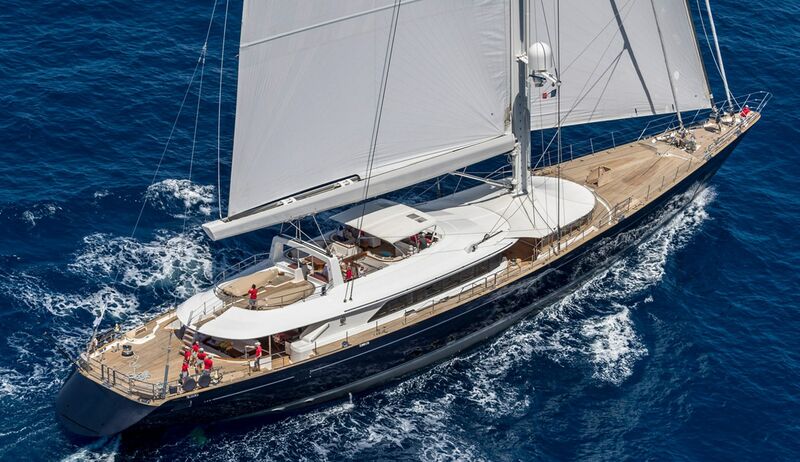On Monday morning at 5 a.m. the superyacht Bayesian sank off the coast of Sicily, leaving one man dead and six people missing. Among the unaccounted for are the British tech tycoon Mike Lynch, who had been enjoying a celebratory cruise after a US jury acquitted him of fraud charges in June, and his 18-year-old daughter, Hannah. Fifteen people, including a baby, were rescued from the ship, after being found crammed into a nearby lifeboat.
The incident would have played out in a handful of horrific minutes.
How did the 56 meter Bayesian come to sink? Each of the current theories suggest the incident would have played out in a handful of horrific minutes.
Experts believe that a storm in the area created a waterspout (a sea tornado) and 100 mph winds, which blew towards the £14 million superyacht, along with thunder and lightning. Survivor Charlotte Golunski said the boat started rocking and taking on water, before she was thrown into the sea. For a few terrible seconds she lost her baby daughter in the waves, but managed to retrieve her and keep her from drowning.
At some point it appears that the vessel’s massive mast snapped, crashing into the sea, and then the ship capsized – sealing the Bayesian’s fate. The majestic yacht will have had a swift plunge to the seabed near the village of Porticello, in Palermo, Sicily.
It may prove to be the case that Bayesian’s 75-meter-high aluminium mast – one of the world’s tallest – was her undoing, acting as a pendulum as she rocked in the water, adding momentum to each successive swing. But the ship’s designers would have meticulously calculated the metacentric height – the distance between the centre of gravity and the metacentre – to prevent this.
Machinery issues cannot be excluded. Every maritime vessel has hull valves for functions such as engine cooling and sanitation. Any of these may have failed. It could also have been that one of the superyacht’s seals, such as the one around the propeller, broke open.
Because the Bayesian was flying under the British flag, she would have been subject to rigid maritime regulations concerning how she was managed at sea, including her crewing. Reading the weather warnings that night, the ship master will have known that, with the ship’s sails down, they would have to use the engine and the anchor to control the boat. It’s the weight of the chain that plants a yacht – rather than the anchor itself – and an insufficient chain length may have allowed Bayesian to be dragged onto rocks, which then punctured her hull.
However Bayesian was sunk though, it is undoubtable that the ship’s master would only have had minutes to respond to the emergency. Royal Navy commanding officers all agree that a captain must think and act decisively during a quickly escalating emergency. Dithering can lead to death in the worst seas.
Fifteen years ago, when the navy ice patrol vessel HMS Endurance’s main engine room filled to the deckhead with sea water in 30 minutes, she was in such a remote position off Chile that her Mayday call went unanswered. It was left the Endurance’s crew, led by Cdr Tom Sharpe to stop her sinking. Eventually informed of the crisis, Prime Minister Gordon Brown said he assumed the Royal Navy would sort the situation. Which Sharpe duly did. But Endurance’s near-miss highlights the loneliness of sea command, whether it is military or civilian. Those in charge must plot a way forward, then take full responsibility when things go wrong. There’s no time to consult onshore expertise.
That can apply wherever you are in the world. While sailors tend to be all too aware that the Atlantic is no benign mistress, capable of whipping up ferocious seas, some still underestimate the Mediterranean. This may be because the sea is enclosed and it can look comparatively small on a map. Seasoned mariners know though that the Med is well capable of creating a fatal storm – and should not be underestimated.
They’re also aware of, and rightly respect, the sheer power of the sea. It’s something I’ve seen first-hand. Like yachts, Royal Navy warships sit high in the water for speed. When I sailed from Rio de Janeiro to the Falklands in a destroyer, we encountered the worst weather the crew had experienced in years. Waves relentlessly smashed over a rolling bridge, and officers of the watch repeatedly ducked down their heads to vomit into a bucket. Anyone not working was in their bunk and genuinely scared junior sailors eyed the captain nervously.
For his part, the commander remained calm and impassive and, once we reached the Falklands, appeared unsurprised to find that thundering waves had twisted the metal ladders on deck.
For the 12 guests on board Bayesian, and her ten-strong crew, the obvious danger they were in will have been clear to them the moment they were abruptly awoken. It would have been chaotic on board, with a clamorous din and desperate scramble for a lifeboat.
It’s now a tragedy Britain’s Marine Accident Investigation Branch, who have already arrived in Palermo, will have to assess.
Ultimately, if Bayesian was hit full-on by a waterspout, she would have been unlikely to survive, no matter what the crew did. Fate certainly seems to have dealt the most brutal of blows to those joyously gathered on the Bayesian to celebrate in the Mediterranean sunshine this summer.







Comments